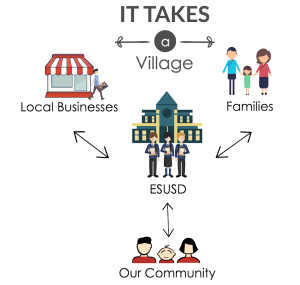Prior to 1978 and Prop 13, school districts were largely dependent upon property taxes, which furnished about 2/3 of public education revenues. Around the same time Prop 13 became law, the Serrano vs. Priest lawsuit challenged the fairness of the funding inequities that resulted from widely disparate property values and tax bases. The combined effect of Prop 13 and Serrano was to shift public school support from local property taxes to State general funds, thereby shifting the control from local authority to the State. Consequently, the State now determines every districts’ per student funding amount.
In addition to lacking local control over tax revenue, our state has limited sources of revenue for schools. The passage of Proposition 13 in 1978 reduced revenue available for education funding. Instead, it comes from business and personal income taxes, sales taxes, and some special taxes—all of which fluctuate. Because of that fluctuation, school funding is especially difficult.
Each year the State legislature determines how much money each school district will receive as a base amount for each student enrolled. Additional funds are typically granted to districts in the form of Categorical Spending, or funds designated for specific programs tied to district demographic factors, socioeconomic or otherwise.
California has fallen in per pupil funding to rank 49th amongst the 50 states, and might actually end up in last place over the next few years! The most considerate States spend as much as three times more.
Although the District’s operating costs rise each year (even before addressing staff salaries), the State does not always implement a cost of living adjustment to that per student base amount. So when costs such as utilities or health benefits rise, the District has to find the money to fund the increased costs.
Since most of the District budget is salary, the only way to balance the ESUSD budget is to raise funds from other sources or to eliminate positions. Thus, the District cannot depend on the State alone to fully fund its budget. PTA can pay for things (e.g. smart boards, supplies, tablets) while Education Foundations fund money to start programs (e.g. Counselors, CGI (Common Core Math) ) which essentially add to the district’s general fund. The Foundation works collectively with district leaders, school principals, and the Board of Education to come up with funding priorities. We focus on trying to make an impact on all the students in the district. Together, we can make a comprehensive difference and narrow the w-i-d-e-n-i-n-g gap created by the State!

Diminished government support for public education in America has forced communities to form education foundations to raise funds to support the public schools in their cities. Several of these organizations can be found in neighboring communities who have built thriving education foundations over the past 30 years. We encourage you to visit their websites to see how compelling and successful these foundations have become – all directly supporting their districts and protecting the reputation of their communities as a destination for excellence in public education: Palos Verdes, Santa Monica/Malibu, Redondo Beach, Torrance and Manhattan Beach…just to name a few.
While free public education is possible, you get what you pay for. We at the El Segundo Ed! Foundation want a GREAT public education for our ESUSD students, and that, unfortunately, is not free.



